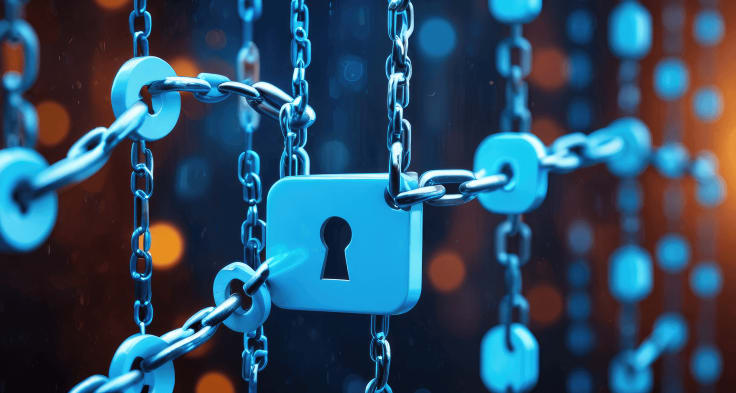Showing top 0 results 0 results found
Showing top 0 results 0 results found

Modern businesses rely heavily on technology to help manage their daily operations. This includes storing sensitive data and communicating with users. As with any technology, there are potential drawbacks, particularly in the area of security.
These data “breaches” can come in various forms, including data theft and ransomware attacks, which can cause serious damage to a business’s reputation and stability. However, you can prevent these by using strong VPN services, such as ExpressVPN or NordVPN, good data encryption, and an effective incident response plan. Advanced chatbots enhance these measures by providing real-time monitoring, automated threat responses, and quick detection of suspicious activities, significantly reducing incident response times.
Several companies offer advanced chatbot platforms on a subscription basis to help with data protection and cybersecurity. In this article, we'll explore how chatbots specifically contribute to handling security breaches and the benefits of integrating them into your cybersecurity strategy.
What is a security breach?
Before we discuss how chatbots can help with incident response, you need to understand a security breach.
They can do this through various means, including malware, phishing attacks, or exploiting system cracks. Many businesses suffer from these attacks and experience data and financial loss, which could damage their reputation.
What is incident response and how do chatbots affect its process?
Chatbots make the whole process easier. Chatbots are automated programs that simulate action, either through texts or voice. They are very common in various industries, especially in customer service, offering instant support to users via communication channels.
Chatbot security best practices for protecting sensitive data
In the case of incident response, AI chatbot integration helps simplify and automate the six steps required to identify and prevent security breaches.
Step 1: Preparing and learning about breaches
This first step is the preparation stage, and AI chatbots play a major role in educating employees about the best data privacy measures. This includes organizing regular training sessions and providing answers to chatbot security-based questions.
For example, if an employee receives a suspicious email, the first thing they should do is consult the AI chatbot system for advice on whether it might be a phishing attempt and what actions to take. They could also refer back to their previous training on how to handle the process.
Step 2: Detecting the breach
The next step is the detection phase, which deals with identifying and verifying when a security breach occurs. You can integrate AI chatbots with other security tools to monitor for any irregularities and suspicious activities. These programs can analyze log files, network traffic, and user behavior to identify any unusual pattern that could pass as a data breach.
If a data breach is discovered, the program can inform the chatbot security team and provide a detailed review of the incident. This would normally include the time of the data breach, the type of attack, and the systems affected. With this quick response, the chatbot security team can quickly deal with the crack in the system.

Step 3: Containing the breach
After detecting the security breach, the next step is to contain the damage and prevent it from spreading to other systems. AI chatbots can help by automatically separating the affected systems from the rest. For instance, once the chatbot identifies the attack, it disconnects the infected devices from the network to prevent the malware from spreading.
Also, if you prefer a more manual approach, AI chatbots can guide employees through containing the data breach. They get detailed instructions on how to disconnect from the network, change passwords, and secure sensitive data.
Step 4: Removing the security threat
Once the malware is isolated, the next step is to remove the cause of the data breach. Chatbots can scan the affected systems and identify threats. These programs can also provide step-by-step guides on how to deal with the threat.
Before doing so, ensure you are aware of the root of the security breach. This will allow you to carefully analyze the attack vector, the crack exploited, and what the hacker or unauthorized person did.
Step 5: Recovering the system
The recovery step involves restoring affected systems and data to their normal state. Chatbots can create detailed recovery plans and coordinate the restoration process. For example, these programs can guide the IT team on how to restore sensitive information from backups, reconfigure systems, and test for any remaining threats.
Chatbots can also keep employees informed about the recovery process and provide updates on the status of the affected systems. This helps ensure that everyone is aware of the progress being made and can resume their normal activities as quickly as possible.
Step 6: Learning from the breach
The last stage of the incident response process is the lesson-learned step. This is where the chatbot security system learns and stores information from previous data breaches to improve future incident response efforts. You can use chatbots to compile detailed reports on the incident, including the timeline of events, the actions taken, and the results.
These reports can be used to conduct post-incident reviews and identify areas for improvement. If you are breached through a crack in the system, you can take the necessary steps to cover it up and strengthen the defenses. You can continuously learn from past incidents to improve your business’s incident response features and reduce chatbot security risks.
Try one of the best chatbots on the market.
Benefits of using chatbots in incident response to protect customer data
Here are some advantages of using chatbots in incident response:
24/7 availability
One of the most notable benefits of chatbots is that they operate 24/7. Security breaches can take place anytime, often outside business hours when human staff might not be available. Chatbots are able to monitor systems constantly and react swiftly to incidents no matter the time of day.
Speed
Chatbots can process large volumes of customer data in real time, allowing them to detect and respond to incidents faster than human analysts. The speed with which chatbots can make regular security audits, spot irregularities, isolate affected systems, and initiate containment measures cuts down considerably on potential damages from a breach.
Consistency
Humans are prone to error, which can sometimes cause data breaches and incident response. On the other hand, chatbots follow predefined protocols and processes to ensure consistency in dealing with all forms of incidents.
Efficient communication
Effective and open communication plays an important role during an incident response. If there is ever a data breach in the business data, employees need to be informed immediately and given guidance on handling it.
Future expectations of chatbots in incident response
Chatbots are expected to play an increasingly important role in incident response as AI technology continues to evolve.
Here are a few possible future developments:
- Threat detection systems will be able to scan large volumes of sensitive information on websites in real time to identify attacks that traditional security tools may overlook.
- With more automation, chatbots should be able to take care of measures like containment and mitigation — minimizing the need for human intervention.
- Chatbots would be able to use historical data to predict possible security threats, thereby becoming proactive about preventing breaches.
- Enhanced integration ensures that chatbots can integrate with other security tools and systems to improve incident response.
Conclusion
Chatbots are important programs that help in incident response. You can integrate one to create your personal chatbot security tools, which assist in identifying, containing, and removing malware from a security breach.
There are also advantages to using chatbots in incident response, including 24/7 availability, consistency, speed, and effective communication. As technology continues to advance, so will chatbots. They will play an increasingly important role in data protection.
Don’t forget to give ChatBot a try with this 14-day FREE trial!



